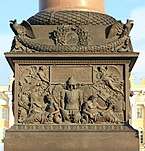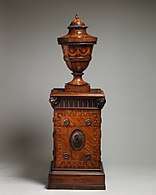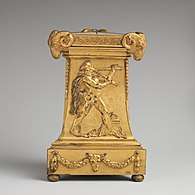Pedestal
A pedestal (from French piédestal, Italian piedistallo, "foot of a stall") or plinth is the support of a statue or a vase, and of a column in architecture. Smaller pedestals, especially if round in shape, may be called socles.
An elevated pedestal or plinth which bears a statue and which is raised from the substructure supporting it (typically roofs or corniches) is sometimes called an acropodium. The term is from the Greek akros or "topmost" and pous (root pod-) or "foot".
Architecture
Although in Syria, Asia Minor and Tunisia the Romans occasionally raised the columns of their temples or propylaea on square pedestals, in Rome itself they were employed only to give greater importance to isolated columns, such as those of Trajan and Antoninus, or as a podium to the columns employed decoratively in the Roman triumphal arches.
The architects of the Italian Renaissance, however, conceived the idea that no order was complete without a pedestal, and as the orders were by them employed to divide up and decorate a building in several stories, the cornice of the pedestal was carried through and formed the sills of their windows, or, in open arcades, round a court, the balustrade of the arcade. They also would seem to have considered that the height of the pedestal should correspond in its proportion with that of the column or pilaster it supported; thus in the church of Saint John Lateran, where the applied order is of considerable dimensions, the pedestal is 13 feet (4.0 m) high instead of the ordinary height of 3 to 5 feet (1.5 m).
Asia
.jpg)
In Asian art a lotus throne is a stylized lotus flower used as the seat or base for a figure. It is the normal pedestal for divine figures in Buddhist art and Hindu art, and often seen in Jain art. Originating in Indian art, it followed Indian religions to East Asia in particular.
In imperial China, a stone tortoise called bixi was traditionally used as the pedestal for important stele, especially those associated with emperors.[1] According to the 1396 version of the regulations issued by the Ming Dynasty founder, the Hongwu Emperor, the highest nobility (those of the gong and hou ranks) and the officials of the top 3 ranks were eligible for bixi-based funerary tablets, while lower-level mandarins' steles were to stand on simple rectangular pedestals.[2]
See also
- Pedestal desk
- Pedestal table, a table with a single central leg
- Tray
- Ozen
- An (Shinto)
Notes
- Stele on the Back of Stone Tortoise Archived 2010-09-19 at the Wayback Machine (an overview of the Bixi tradition)
- de Groot, Jan Jakob Maria (1892), The Religious System of China, II, Brill Archive, pp. 451–452.
References

| Wikimedia Commons has media related to Pedestal. |
| Look up pedestal in Wiktionary, the free dictionary. |
| Look up plynth in Wiktionary, the free dictionary. |
| Look up plinth in Wiktionary, the free dictionary. |


.jpg)

